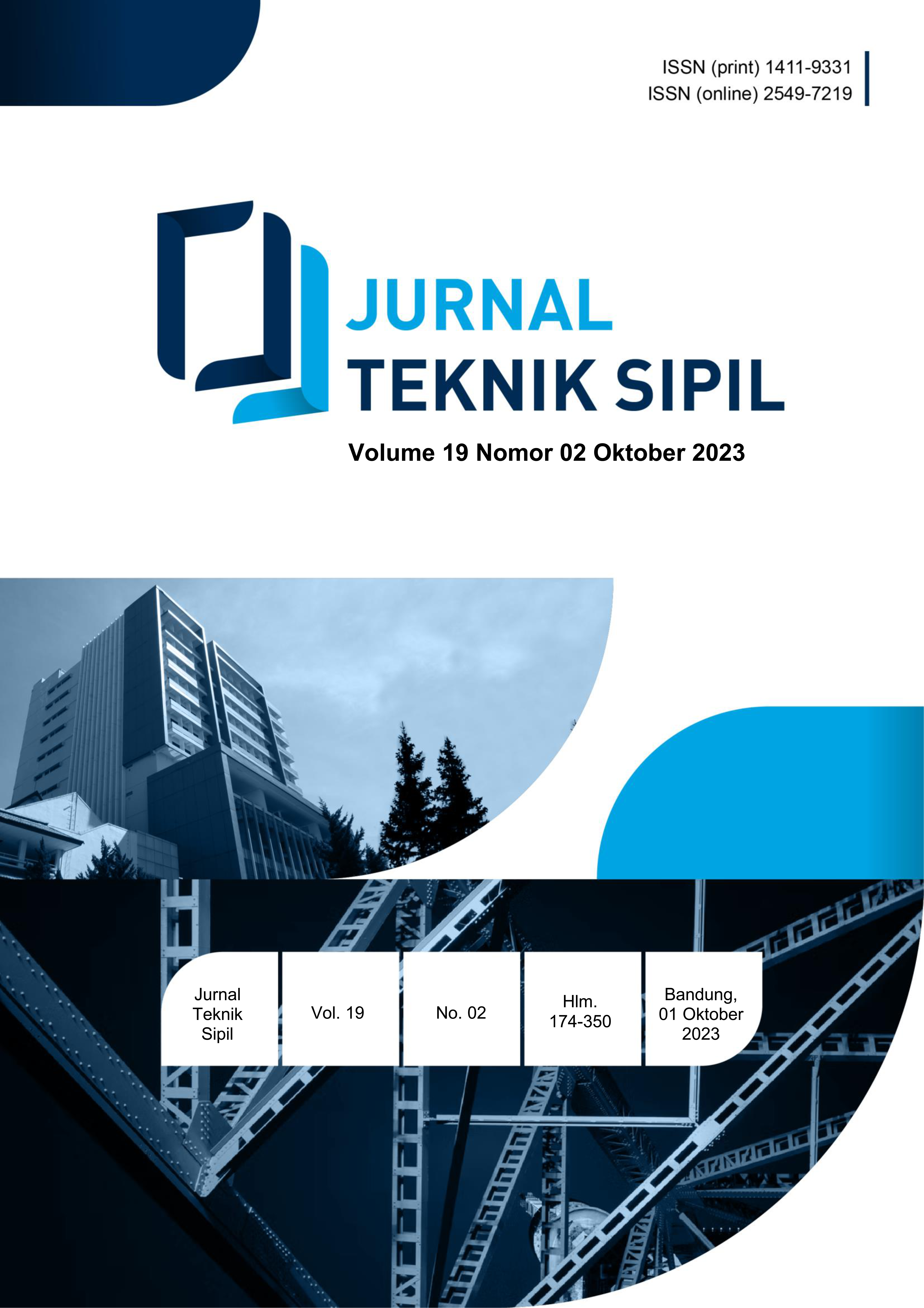Pengaruh Micro Lime pada Beton Geopolimer Berbasis Abu Ampas Tebu yang Diawetkan di Lingkungan Sekitar
DOI:
https://doi.org/10.28932/jts.v19i2.7303Kata Kunci:
Micro lime, Beton Geopolimer, Penyerapan, Kuat Tekan, Green ConcreteAbstrak
Beton geopolymer (geopolymer concrete) telah menjadi pengganti ideal beton Ordinary Portland Cement (OPC) dalam memproduksi green concrete. Bahan pengikat pada beton geopolimer adalah pasta semen yang terbuat dari Aluminosilikat amorf dan diaktivasi dengan larutan Alkali. Proses geopolimerisasi dimulai pada suhu tinggi. Oleh karena itu, proses curing memerlukan suhu tinggi. Metode pengawetan ini membatasi penerapan beton geopolimer dalam industri konstruksi. Dalam campuran geopolimer, keberadaan ion Kalsium memungkinkan pembentukan gel Kalsium Aluminat Silikat dan Kalsium Silikat Hidrat, sehingga memungkinkan proses pengeringan pada suhu sekitar. Oleh karena itu, penelitian ini menyelidiki pengaruh micro lime pada beton geopolimer berbahan dasar Abu Ampas Tebu (Sugarcane Bagasse Ash-Based, SCBA). Micro lime yang ditambahkan pada beton geopolimer sebanyak 1, 3, 5 dan 7% berat SCBA. Desain campuran didasarkan pada Algoritma Densified Mix Design. Pengujian yang dilakukan meliputi compressive strength dan water absorption. Ambient curing pada beton geopolimer berbasis SCBA dicapai dengan 1% micro lime. Compressive strength meningkat dengan bertambahnya micro lime, 10N/mm2 pada 1%, menjadi 18,25N/mm2 pada micro lime 7%. Beton geopolimer pada ambient temperature-cured dengan micro lime 3% memiliki tingkat penyerapan air terendahUnduhan
Referensi
Abdalla, T. A., Koteng, D. O., Shitote, S. M., & Matallah, M. (2022). Mechanical and durability properties of concrete incorporating silica fume and a high volume of sugarcane bagasse ash. Results in Engineering, 100666. https://doi.org/10.1016/j.rineng.2022.100666
Abdullah, M. M. A. B., Meor Ahmad Tajudin, M. A. F., Mohd Tahir, M. F., Abdul Kadir, K., Sandu, A. V., Isa, N., & Corbu, O. C. (2017). Performance and Characterization of Geopolymer Concrete Reinforced with Short Steel Fiber. IOP Conference Series: Materials Science and Engineering, 209, 012038. https://doi.org/10.1088/1757-899X/209/1/012038
Adam, A. A., Amiri, N. H., Suarnita, I. W., & Rupang, N. (2016). The Effect of Lime Addition on the Setting Time and Strength of Ambient Cured Fly Ash Based Geopolymer Binder. MATEC Web of Conferences, 47, 01015. https://doi.org/10.1051/matecconf/20164701015
Adam, A., Maricar, S., & Ramadhan, B. (2019). The Effects of Water to Solid Ratio, Activator to Binder Ratio, and Lime Proportion on the Compressive Strength of Ambient-Cured Geopolymer Concrete. https://doi.org/10.22146/jcef.43878
Arasa, F. O., Onchiri, R., & Abiero-Gariy, Z. C. (2017). Effect of Sugarcane Bagasse Ash on the Engineering Properties of Blended Sandcrete Blocks. International Journal of Engineering Research & Technology, 6(12). https://doi.org/10.17577/IJERTV6IS120133
Davidovits, J. (2013). Geopolymer Cement a review 2013. 1–11.
Gagg, C. (2014). Cement and Concrete as an engineering material: An historic appraisal and case study analysis. Engineering Failure Analysis, 40. https://doi.org/10.1016/j.engfailanal.2014.02.004
Garcia-Lodeiro, I., Palomo, A., Fernández-Jiménez, A., & Macphee, D. E. (2011). Compatibility studies between N-A-S-H and C-A-S-H gels. Study in the ternary diagram Na2O–CaO–Al2O3–SiO2–H2O. Cement and Concrete Research, 41(9), 923–931. https://doi.org/10.1016/j.cemconres.2011.05.006
Karthiyaini, S. (2016). Physicochemical propertiesof alkali activated fly ash based geopolymer concrete: A review. International Journal of Earth Sciences and Engineering, 9, 2419–2426.
Koteng’, D. O. (n.d.). Concrete use for sustainable development. 19.
Naik, T. (2005). Sustainability of Cement and Concrete Industries. Proceedings of the International Conference on Achieving Sustainability in Construction. https://doi.org/10.1680/asic.34044.0017
Nawaz, M., Heitor, A., & Sivakumar, M. (2020). Geopolymers in construction—Recent developments. Construction and Building Materials, 260. https://doi.org/10.1016/j.conbuildmat.2020.120472
Parveen, Singhal, D., Junaid, M. T., Jindal, B. B., & Mehta, A. (2018). Mechanical and microstructural properties of fly ash based geopolymer concrete incorporating alccofine at ambient curing. Construction and Building Materials, 180, 298–307. https://doi.org/10.1016/j.conbuildmat.2018.05.286
Pavithra, P., Srinivasula Reddy, M., Dinakar, P., Hanumantha Rao, B., Satpathy, B. K., & Mohanty, A. N. (2016). A mix design procedure for geopolymer concrete with fly ash. Journal of Cleaner Production, 133, 117–125. https://doi.org/10.1016/j.jclepro.2016.05.041
Puertas, F., Palacios, M., Manzano, H., Dolado, J. S., Rico, A., & Rodríguez, J. (2011). A model for the C-A-S-H gel formed in alkali-activated slag cements. Journal of the European Ceramic Society, 31(12), 2043–2056. https://doi.org/10.1016/j.jeurceramsoc.2011.04.036
Temuujin, J., van Riessen, A., & Williams, R. (2009). Influence of calcium compounds on the mechanical properties of fly ash geopolymer pastes. Journal of Hazardous Materials, 167, 82–88. https://doi.org/10.1016/j.jhazmat.2008.12.121
Waqas, R. M., Butt, F., Zhu, X., Jiang, T., & Tufail, R. F. (2021). A Comprehensive Study on the Factors Affecting the Workability and Mechanical Properties of Ambient Cured Fly Ash and Slag Based Geopolymer Concrete. Applied Sciences, 11(18), Article 18. https://doi.org/10.3390/app11188722
Zhang, S. P., & Zong, L. (2014). Evaluation of Relationship between Water Absorption and Durability of Concrete Materials. Advances in Materials Science and Engineering, 2014, e650373. https://doi.org/10.1155/2014/650373
##submission.downloads##
Diterbitkan
Cara Mengutip
Terbitan
Bagian
Lisensi
Hak Cipta (c) 2023 Keithy Kamau, Benard Omondi, Janet Oyaro

Artikel ini berlisensi Creative Commons Attribution-NonCommercial 4.0 International License.
















